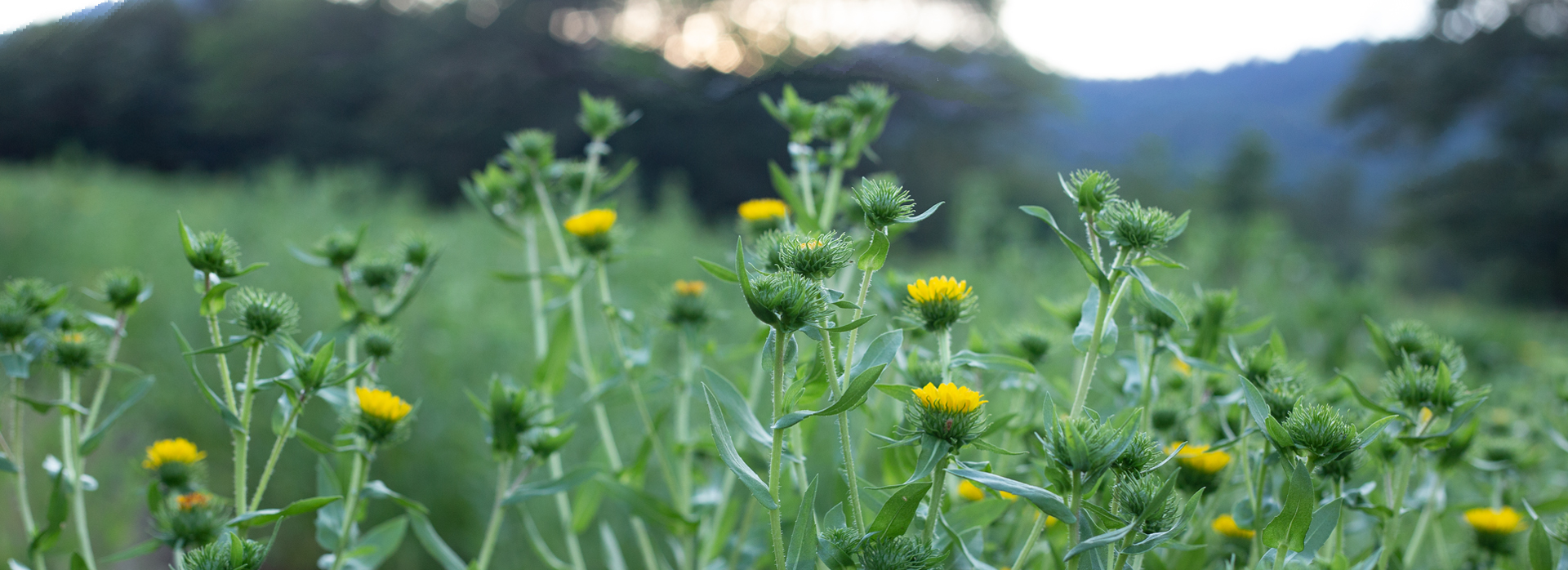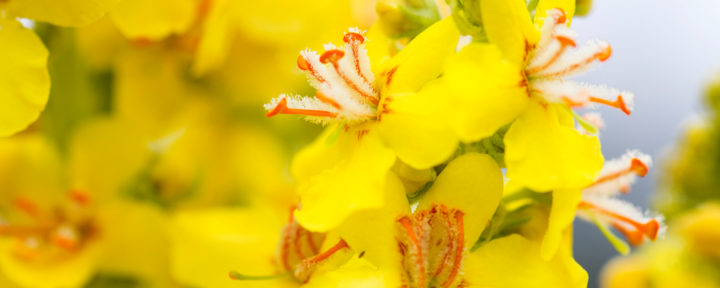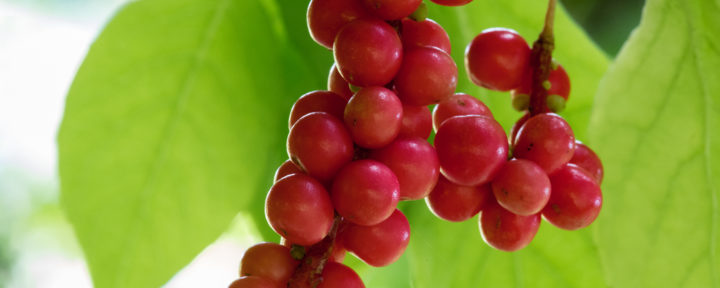You might be familiar with some of the common respiratory herbs, like Goldenrod and Thyme.* This blog will look at some of the more obscure herbs that aren’t as widely known — but have a rich history of traditional use.
From Elecampane and Grindelia to Wild Cherry and Yerba Santa, learn more about eight lesser-known respiratory herbs.* Beyond their use in herbalism, which dates back to ancient times, many of these herbs have interesting stories linked to cultures around the world.
With woolly leaves and beautiful yellow flowers that look like tiny Sunflowers, Elecampane (Inula helenium) is in the same family as Sunflower, the Asteraceae. This plant’s history is full of interesting stories. Its species name, helenium, is named for Helen of Troy, the fabled beauty of ancient Greece. It’s said that Elecampane plants sprung up everywhere her tears fell as she was abducted from Sparta.
In Switzerland and France, Elecampane is one of many herbs used to make absinthe, and it was sacred to the ancient Celts. Some call it Elfwort, as Elecampane was linked to the myth and lore of elves and fairies.
You’ll find it as a single herb extract as well as an ingredient in Lung Expectorant™ and Rapid Immune Boost™.
Botanical name: Inula helenium
Plant family: Asteraceae
Native habitat: Europe and Asia
Parts used: root
Use(s): Traditional support for the respiratory system*
Flavor profile: intensely aromatic and resinous with bitterness and acidity
Native to Europe, Eyebright (Euphrasia spp.) has lovely little flowers that are almost too pretty to seem real — they have yellow centers, white petals and violet or purple markings. Some say they resemble an eye. They earned their common name based on historical use and are part of the Orobanchaceae family.
We include Eyebright in Herbs on the Go: Ready for Pollen™, Pollen Defense™ and Kids Sinus Samurai™.
Botanical name: Euphrasia spp.
Plant family: Orobanchaceae or broomrape family
Native habitat: Europe
Parts used: flowering herb
Use(s): Traditional support for the respiratory system*
Flavor profile: smoky, slightly bitter
Like Elecampane, Grindelia is a member of the Asteraceae. The plant’s yellow flowers are high in sweet-smelling resins and are very sticky — one common name is, in fact, Gumweed. This is a bit of a misnomer since it's sticky from resin and not gum. You’ll find Grindelia growing in varied environments from near the ocean in brackish marshes to dry mountains. It has long been used by Native Americans.
Grindelia is available as a single extract and as an ingredient in our Calm Breathing™ formula.
Botanical name: Grindelia integrifolia
Plant family: Asteraceae
Native habitat: North and South America
Parts used: leaf and flower
Use(s): Traditional support for the respiratory system*
Flavor profile: balsamic, aromatic, sweet and characteristic
A member of the Lamiaceae or Mint family, Horehound (Marrubium vulgare) has a history that dates back to ancient Rome and Egypt, where it was used in herbalism and to flavor candy and lozenges.
Its genus name, Marrubium, has more than one origin story, not uncommon among plants that have been used across cultures. Some believe it to be derived from the name of an ancient town in Italy, while others link its name to the Hebrew word marrob for “a bitter juice.” With crinkled leaves covered in white hairs, Horehound is believed to be one of the bitter herbs of Passover.
We offer Horehound as a single herb extract.
Botanical name: Marrubium vulgare
Plant family: Lamiaceae
Native habitat: Mediterranean Europe and Asia
Parts used: flowering herb
Use(s): Traditional support for the respiratory system*
Flavor profile: highly aromatic, very bitter, distinctive
Osha (Ligusticum porteri) is widely used in Native American cultures across the mountainous regions where it grows. It is also called Porter’s Lovage, but some know it as Bear Root, as bears are said to dig it up and eat the roots after hibernation. They also rub some of the strong-smelling plant on their fur.
This member of the Apiaceae or Carrot family (which also includes Celery and Cilantro) is difficult to cultivate on a commercial scale, so ours is always responsibly wildcrafted.
You’ll find Osha as a single herb extract.
Botanical name: Ligusticum porteri
Plant family: Apiaceae
Native habitat: Southern Rocky Mountains and associated mountains of the Turkey and into Mexico
Parts used: root
Use(s): Traditional support for the respiratory system*
Flavor profile: sharp, intense aromatic quality resembling strong Celery, characteristic

You might be more familiar with another common name of Pleurisy Root (Asclepias tuberosa) — Butterfly Weed. This plant is beloved by monarch butterflies, as it provides food for their larvae as well as nectar for adults.
This species of Milkweed contains several resins and was an important herb among North American indigenous communities. A member of the Apocynaceae or Dogbane family, Pleurisy Root is easily recognized by its clusters of bright orange flowers.
We offer a single herb extract of Pleurisy Root (and grow plenty of it for the butterflies).
Botanical name: Asclepias tuberosa
Plant family: Apocynaceae
Native habitat: North America
Parts used: root
Use(s): Traditional support for the respiratory system*
Flavor profile: aromatic, bitter
Wild Cherry (Prunus serotina) bark has been traditionally used in herbalism, while the wood is prized by cabinetmakers and woodworkers. The fresh bark smells like Almonds, due to the phytochemical benzaldehyde. Also known as Black Cherry, Wild Cherry was one of the most popular herbs used by Native Americans and later European pioneers. The plant is in the Rosaceae or Rose family and related to many fruit trees, and as the family name suggests, Roses.
We use Wild Cherry bark in Herbal Respiratory Relief™ and Kids Cough Crusader™
Botanical name: Prunus serotina
Plant family: Rosaceae
Native habitat: North America
Parts used: bark
Use(s): Traditional support for the respiratory system*
Flavor profile: sweet, fruity, characteristic with a slightly astringent mouthfeel
Yerba Santa (Eriodictyon californicum) is a member of the Boraginaceae or Borage family. It goes by many names, several of which mean “sacred or holy herb.” Known to some as Mountain Balm, Tarweed and Gum Plant, Yerba Santa is known for being high in phenols and sticky resins.
The herb has an aromatic, balsamic scent and taste, and it has long been valued in Native American herbalism.
We include it in Lung Expectorant™ and Rapid Immune Boost™, and we make a single herb extract, too.
Botanical name: Eriodictyon californicum
Plant family: Boraginaceae
Native habitat: Istanbul, Bursa and into Baja Mexico
Parts used: herb
Use(s): Traditional support for the respiratory system*
Flavor profile: aromatic, balsamic, slightly sweet











